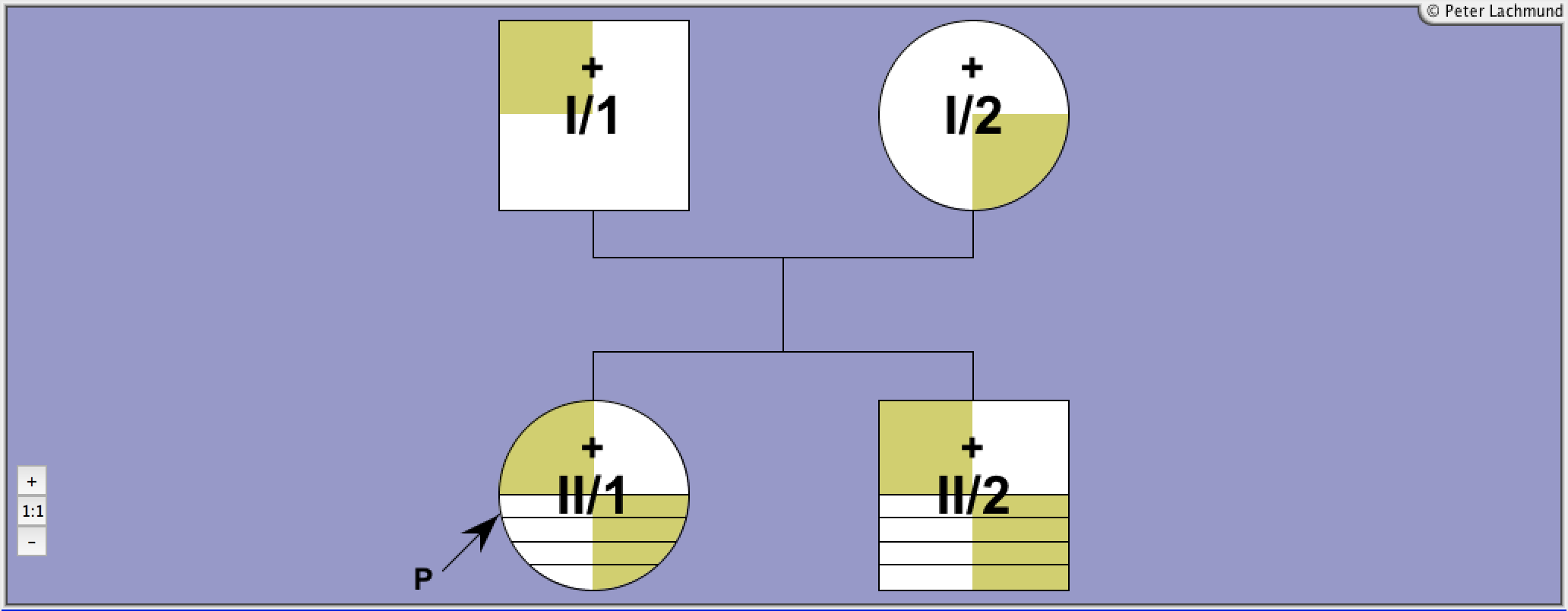Details Of Published TSH Receptor Mutation
Asp 410 Asn
c.1228G>AInactivating TSH Receptor Mutation
Type
loss
Manifestation
family
Exon
10
Legend:

Male

Female

Unknown

Deceased
+
Mutation
-
Wild-Type

Heterozygous

Heterozygous

Compound Heterozygous

Homozygous

Hypothyroid

Hypoplastic Gland + Hypothyroid
P
Index Patient
Molecular Characteristics:
Family 1 - pedigree 1 (de Roux et al.):
I/1: Gln324Stop
I/2: Asp410Asn
II/1-2: Gln324Stop/Asp410Asn
compound heterozygous
Family 2 - pedigree 2 (Tonacchera et al.):
II/2, II/1: heterozygous
Family 3 - pedigree 3 (Nicoletti et al.):
propositus and mother heterozygous
I/1: Gln324Stop
I/2: Asp410Asn
II/1-2: Gln324Stop/Asp410Asn
compound heterozygous
Family 2 - pedigree 2 (Tonacchera et al.):
II/2, II/1: heterozygous
Family 3 - pedigree 3 (Nicoletti et al.):
propositus and mother heterozygous
Clinical Features:
Family 1 - pedigree 1 (de Roux et al.):
diagnosis:
II/1-2: neonatal, euthyroid hyperthyrotropinaemia,
slightly enlarged gland on 123-I scan
normal Tg levels (Gln324)
Family 2 - pedigree 2 (Tonacchera et al.):
Family 2 (Tonacch)
II/1 (proposita): 31yr, TSH elevated
II/2: sister, isolated hyperthyrotropinaemia
parents: dead
Family 3 - pedigree 3 (Nicoletti et al.):
propositus: growth delay
both: hypercholesterolemia
diagnosis:
II/1-2: neonatal, euthyroid hyperthyrotropinaemia,
slightly enlarged gland on 123-I scan
normal Tg levels (Gln324)
Family 2 - pedigree 2 (Tonacchera et al.):
Family 2 (Tonacch)
II/1 (proposita): 31yr, TSH elevated
II/2: sister, isolated hyperthyrotropinaemia
parents: dead
Family 3 - pedigree 3 (Nicoletti et al.):
propositus: growth delay
both: hypercholesterolemia
Treatment:
L-thyroxine
Functional Characteristics:
cAMP
(basal)
(basal)
cAMP
(TSH)
(TSH)
IP
(basal)
(basal)
IP
(TSH)
(TSH)
TSH-Binding
Cell Surface Expression
Prevalence
LRA
Ref
-
+
nd
nd
-
-
3
Legend:
cAMP (basal): basal in vitro cAMP production of mutant over wild-type TSHR
cAMP (TSH): maximal in vitro cAMP production of mutant over wild-type TSHR
IP (basal): basal in vitro IP production of mutant over wild-type TSHR
IP (TSH): maximal in vitro IP production of mutant over wild-type TSHR
TSH-binding: maximal TSH-binding compared to the wild-type TSHR
Cell surface expression: cell surface expression of mutant compared to WT-TSHR
LRA: linear regression analysis (LRA) of constitutive activity as a function of TSHR expression determined by 125I-bTSH binding or FACS analysis compared to the wild-type TSHR
Prevalence: Prevalence of (somatic and germline) activating mutations*
Ref: Reference for functional characterization
Child: Found in children.
Reference 1:
De Roux et al.
J. Clin. Endocrinol. Metabol. 81: 4229-4235
Four families with loss of function mutations of the thyrotropin receptor
1996
Reference 2:
Nicoletti et al.
J Clin Endocrinol Metab 94:4187-4194.
Thyrotropin-stimulating hormone receptor gene analysis in pediatric patients with non-autoimmune subclinical hypothyroidism.
2009
Reference 3:
Tonacchera et al.
Clin Endocrinol (Oxf) 67:712-718.
Identification of TSH receptor mutations in three families with resistance to TSH.
2007



